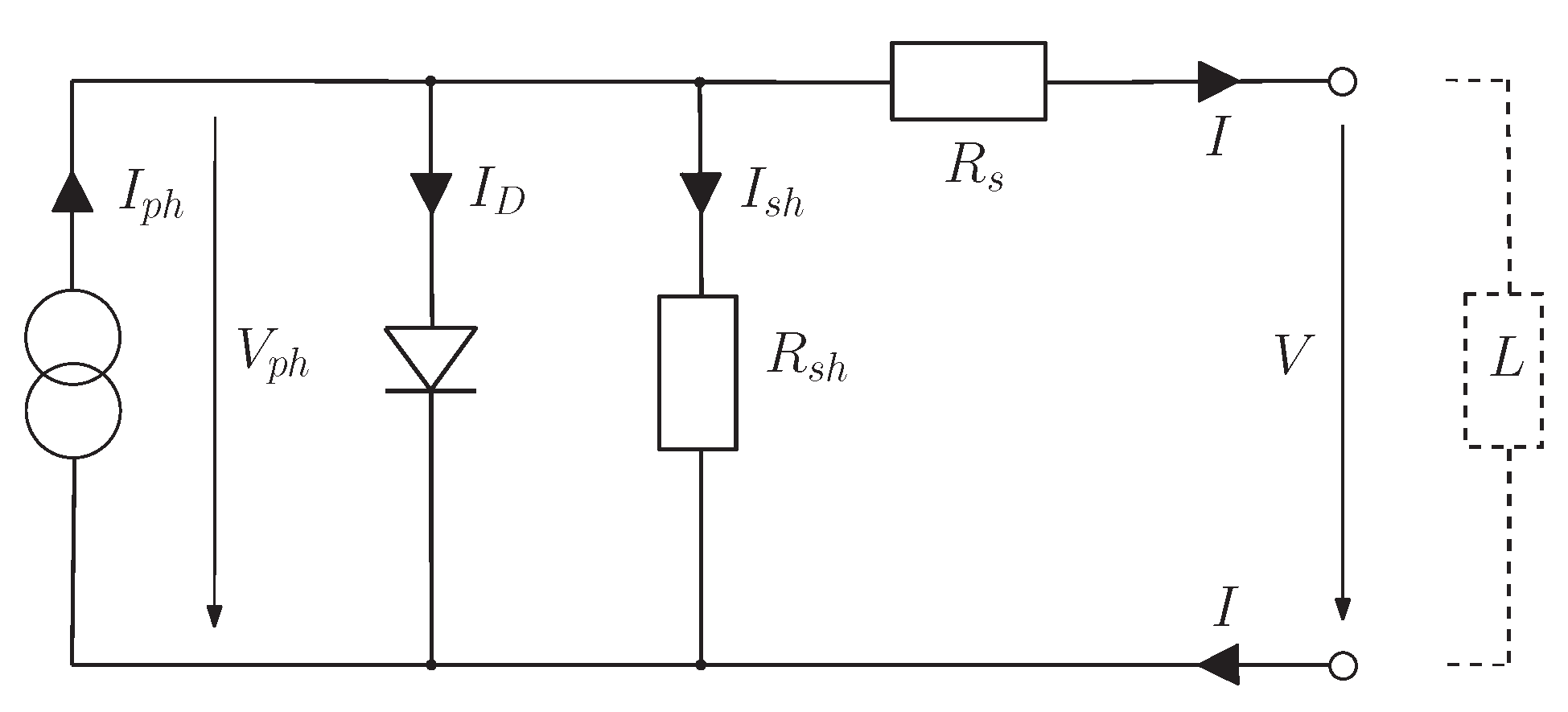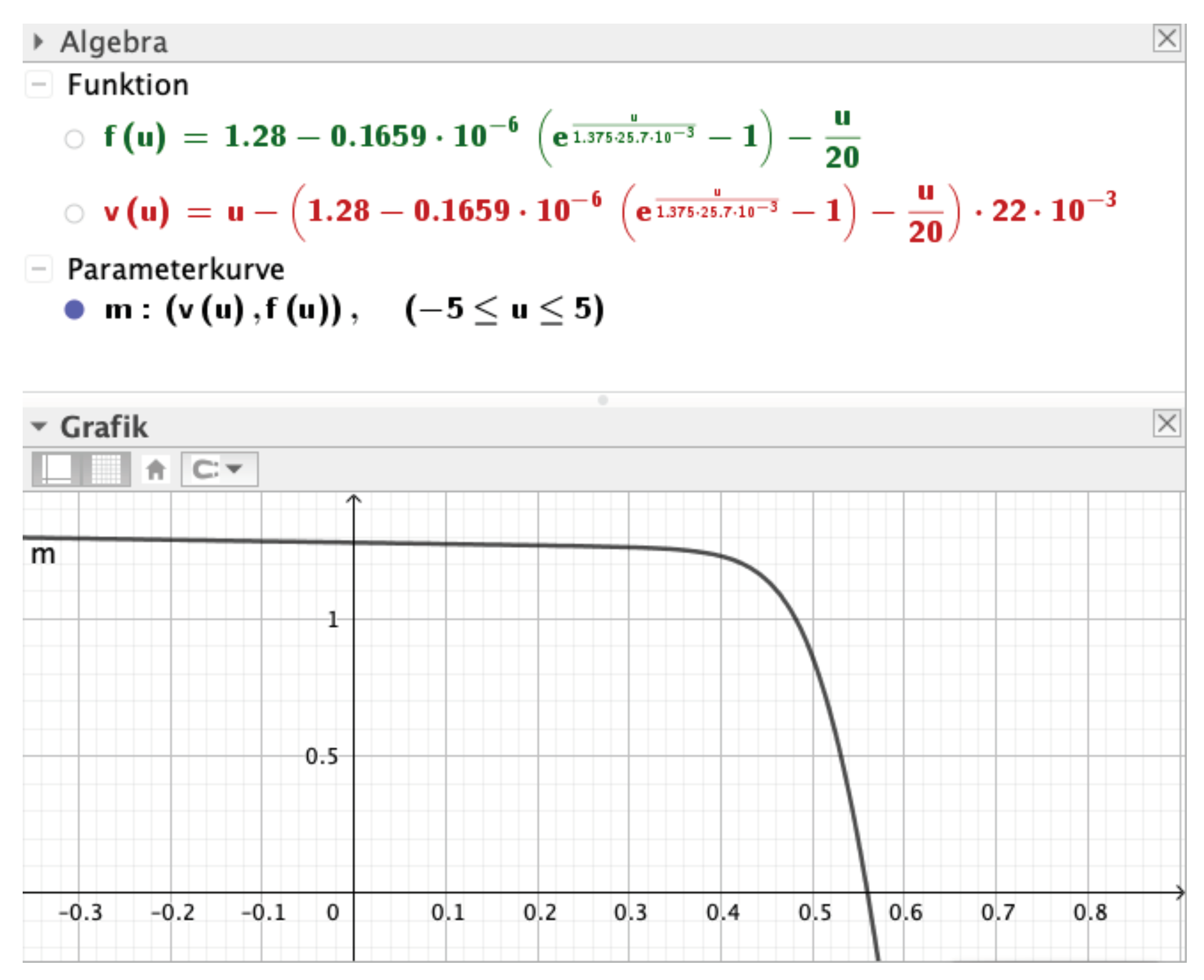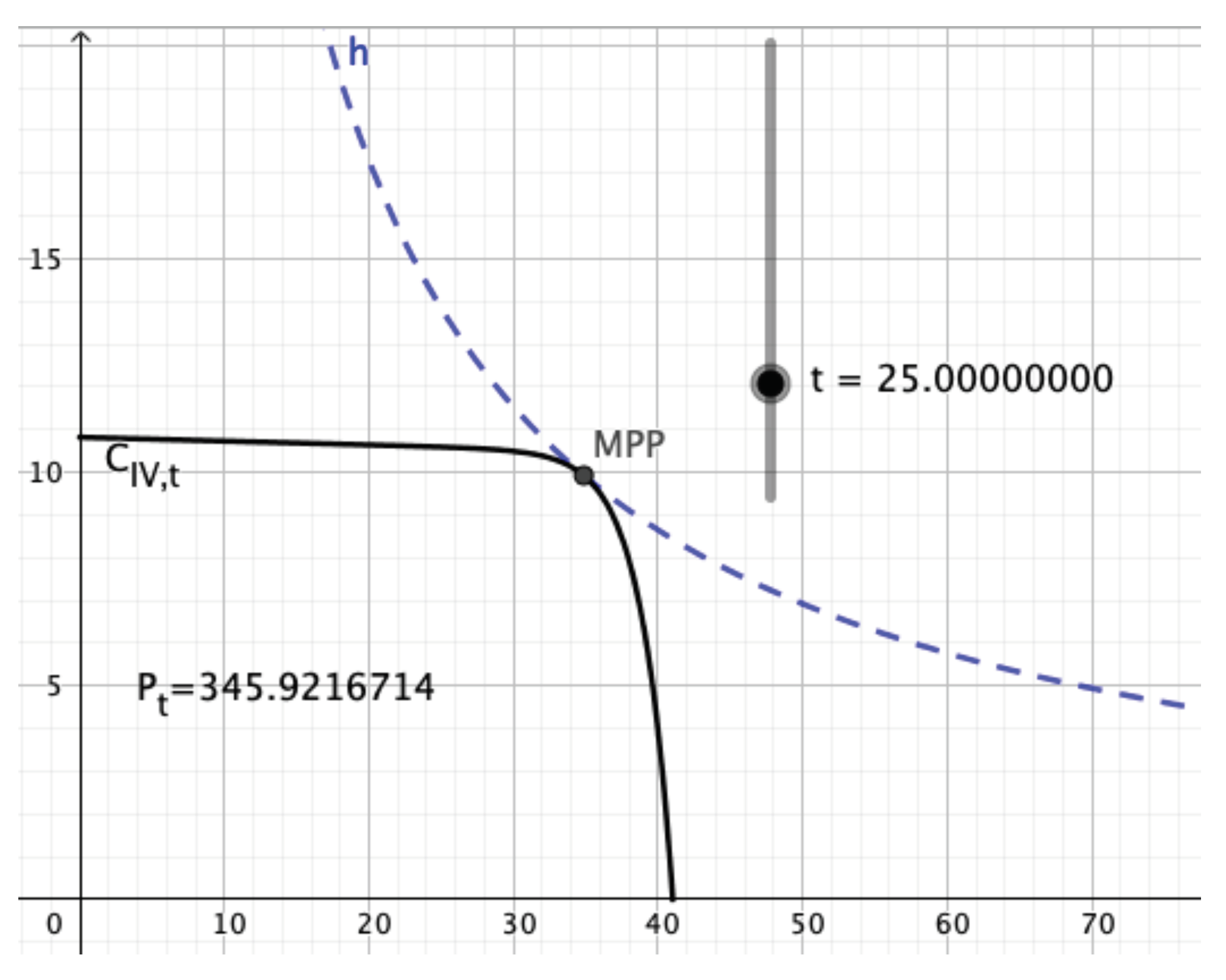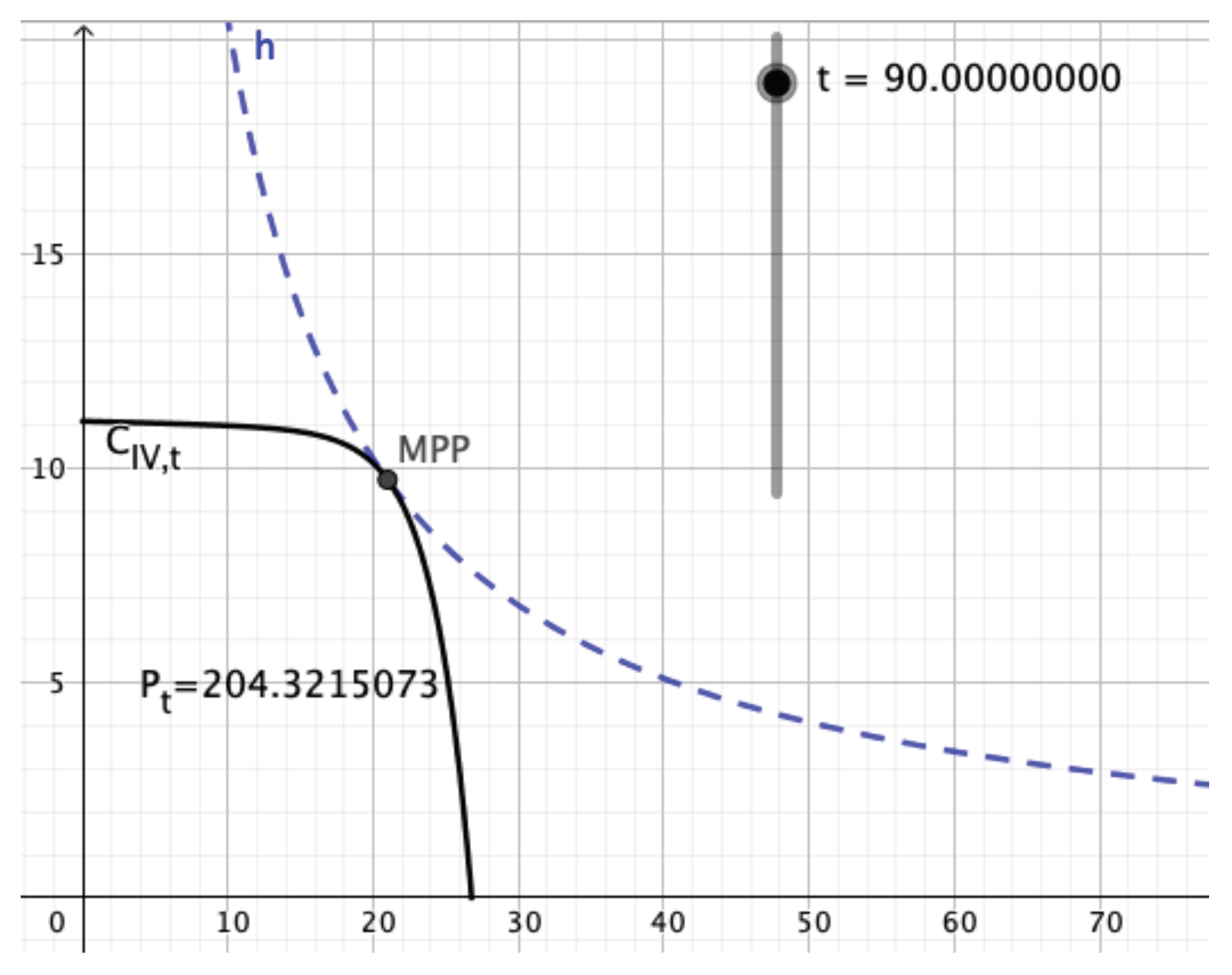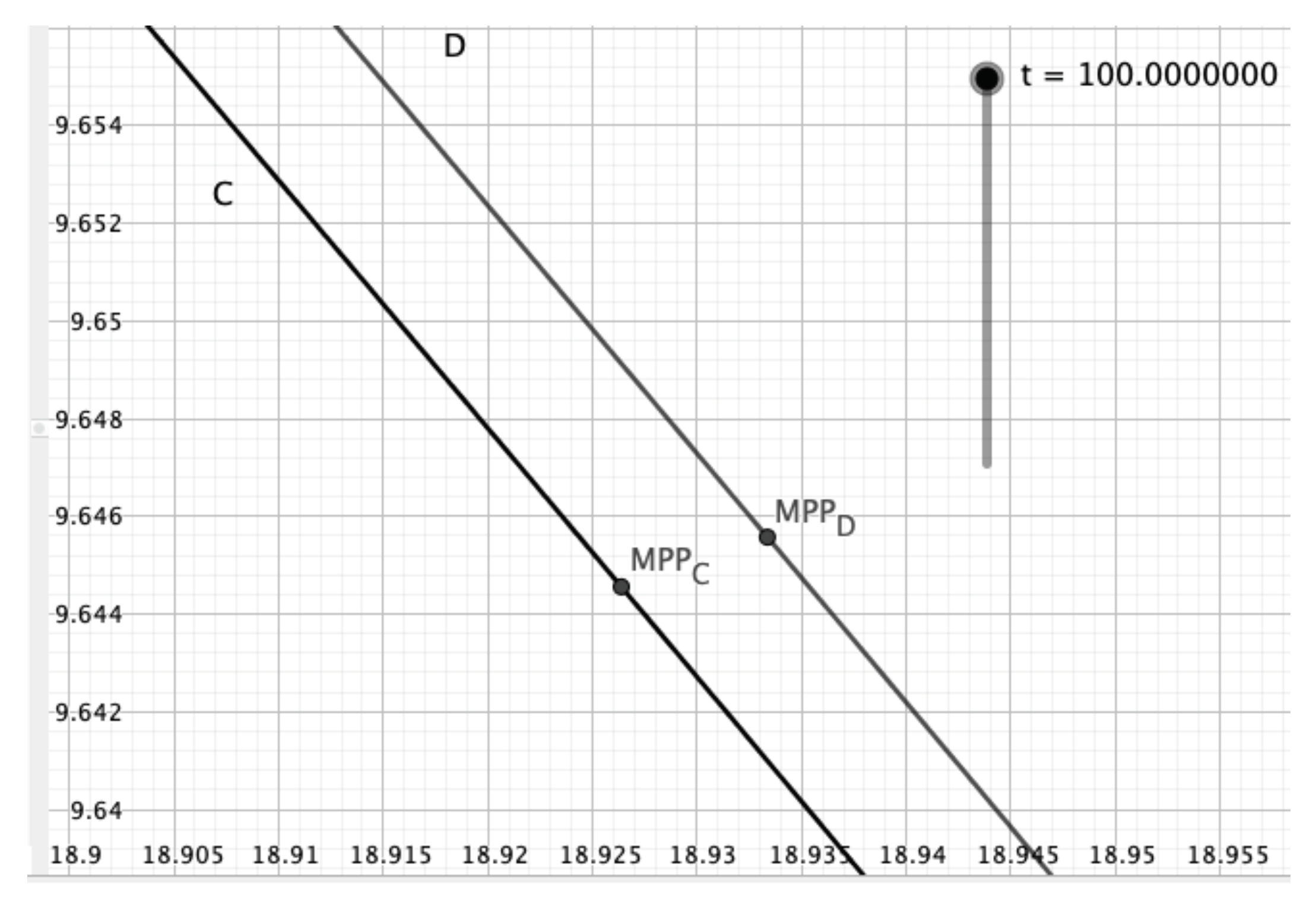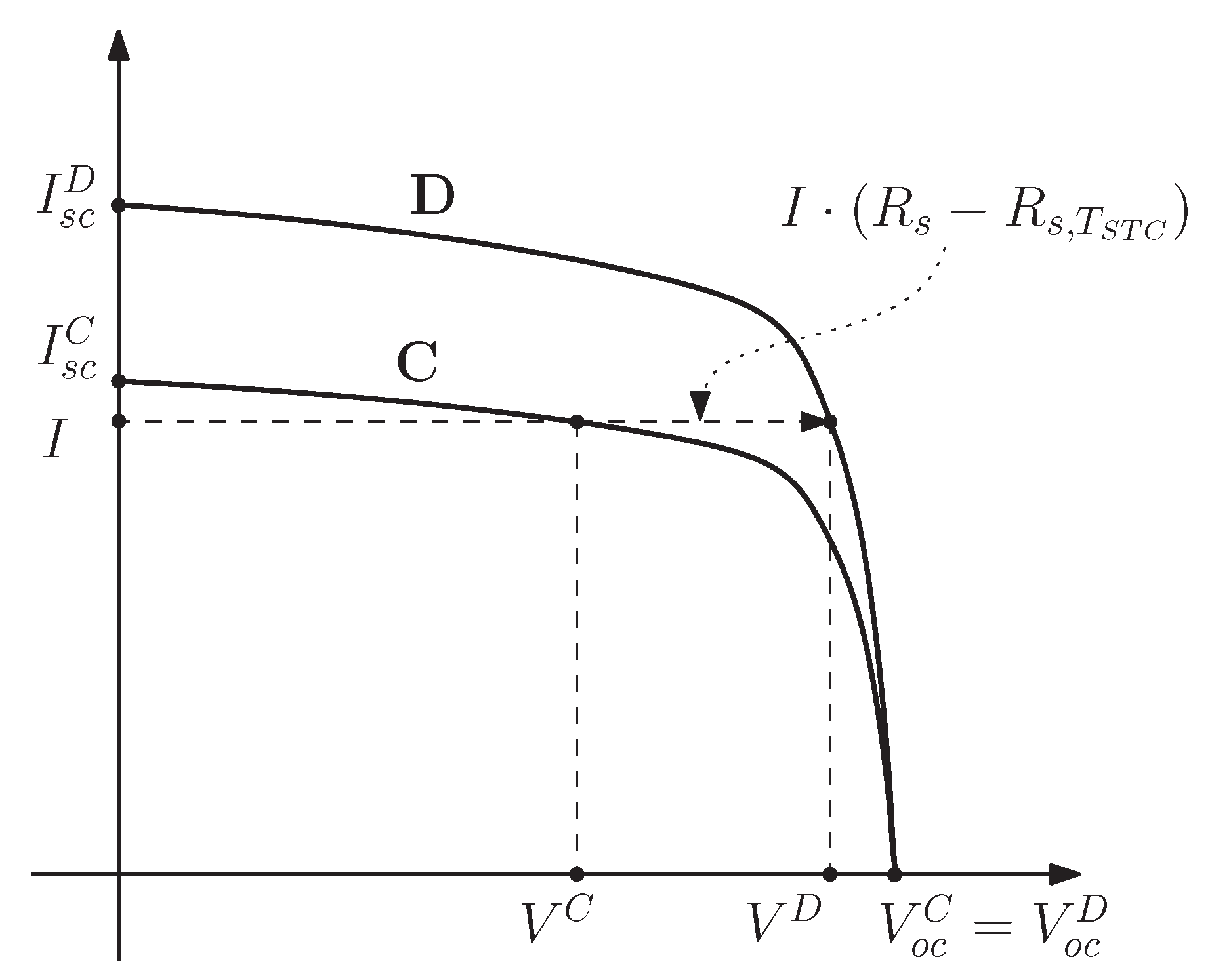1. Introduction
Solar energy is of great importance to help us reduce, and finally eliminate, the use of fossil energy. As an increasing number of photovoltaic systems are appearing in public and in private installations, knowledge of their basic properties should be made easily accessible. On this note, we attempt to take a step in this direction. Before we get started, let us look at some background information first.
Both voltage V and current I generated by a photovoltaic cell depend on the load L it has to feed. In order to compute the maximum power the cell can deliver to suitable L, one needs to know the mutual dependency of V and I; that is, the I–V curve . To this end, different models of solar cells have been suggested.
Figure 1 shows the widely used single-diode model. Here, current
I delivered to load
L is given by
A photogenetic current
is supposed to be provided by the solar generator. Both diode current
and the current
through shunt resistor
depend on the voltage
at the generator, which is related to
V by
taking the voltage drop at resistor
into account. Using the Shockley diode equation to obtain
, Equation (
1) implies the well-known formula
Here,
denotes the reverse saturation current of the diode,
n equals the diode’s ideality factor, and
stands for the thermal voltage.
Even when the values of
,
,
n,
and
are known, the challenge is in expressing
I as a function of
V, or vice versa. To this end, one can rewrite (
3) as equation
The implicit function theorem [
1] implies that there exist local solutions
satisfying
in a neighborhood of each value of
V, but an explicit expression for
by elementary functions (functions such as polynomials, roots, exp and ln, trigonometric functions and their inverses, and finite combinations of these are usually called elementary or of closed form) is not known. Thus, one has to resort to numerical methods.
In [
2], it has been shown how to use Newton’s method to approximate, for a given voltage
V, the associated current
I, satisfying
. The Newton method is a universal iterative algorithm for finding zeroes of smooth real-valued functions. For a sequence of
V-values
, it can be used to approximate the associated values
satisfying
, with an accuracy depending on the number of iterations. Processing the values
one by one leads to a sequence of points
arbitrarily close to
, but it does not provide us with a global solution
of equation
or, vice versa, a solution
.
Then, in [
3], such a solution
for
V has been given in terms of the Lambert
W-function,
More precisely, the authors succeeded in separating the two variables
V and
I in (
3) by providing an equation of type
with elementary functions
a and
b that involve the parameters of
but neither
V nor
I. Lambert function
W itself is known to be
not elementary, so that, again, it takes the Newton method or some other iterative algorithm to approximate it. However, because the
W function occurs so frequently, efficient implementations of
are available in advanced math systems that can be used in commercial circuit simulators. They allow
curves to be drawn by a plot command that triggers numerous computations of
W in the background.
The purpose of this paper is twofold. As a theoretical contribution, we present, in
Section 3.1, an exact description of
I–
V curves by elementary functions. Instead of writing
I as a function of
V, we express both as functions
and
of a real parameter
u. In this way,
is obtained as the image of the mapping
from an
u-interval into the
-plane.
and
are directly implied by Equation (
3). This approach will be described for the single-diode model; it can easily be generalized to the double-diode model and to Bishop’s model [
2].
Then, in
Section 3.2, we derive practical benefit from our parameterization. We demonstrate that it can be used to implement, by a few lines of code, interactive tools for studying the influence of environmental parameters on
curves. Even on a hand-held device, one can observe how a
curve, the location of its maximum power point MPP, and the maximum power smoothly change as the circuit’s temperature is altered on a slider. The influence of variable irradiance or angle could be incorporated as well.
Such tools allow research questions to be investigated using simple means. For example, there seems to be a discussion in the community as to whether the value of series resistor
should be modeled to grow with increasing temperature [
4], or whether it could be considered constant [
5]. For the parameters of a real PV module studied in [
4], our simulation shows that the difference is surprisingly small. At 100 °C, power at MPP computed for increasing
equals 182.54 W; if
remains constant, peak power is larger by only 80 mW. A closer inspection of Equation (
3) confirms this finding directly.
Some technical facts will be needed below. In practice, not only single cells are being considered, but also photovoltaic modules consisting of a number
N of identical cells in a series circuit. Here, the single-diode model can also be applied if all cells are subjected to identical environmental parameters. In this case, thermal voltage
must be multiplied by
N in Equation (
3).
Given a real solar cell or module, one can measure its
I–
V curve experimentally. In [
6], the authors review different types of variable loads
L that can be used to this end. Typically, such measurements are being taken under standard test conditions (STC), where the cell is operated at a temperature of
Celsius and receives an irradiance of 1000 W/m
, of light whose spectrum corresponds to an incoming angle of
. Of the parameters mentioned above, the thermal voltage is thus fixed to
where
is the Boltzmann constant,
denotes the elementary charge, and
states the absolute temperature in Kelvin.
Several methods for extracting the missing parameters
,
,
n,
and
from measurements have been reviewed in [
7]. The analytic approach of [
8,
9] makes use of information supplied by manufacturers’ data sheets, namely the values, under STC, of the open circuit voltage
, shortcut current
, and the maximum power point MPP. They already provide three points,
and
on the curve
to be constructed. Additionally, its tangent at MPP
is known to be of slope
, since the derivative of
by
V must vanish at MPP. In addition, the tangent slopes of the measured curve at
and
can be taken. Based on these data, a satisfactory presentation of
can be obtained [
5]. In this note, we assume that the parameters at
STC are given.
2. Electrothermal Modeling
The performance of solar cells is strongly influenced by temperature and irradiation. While irradiance measures the total radiant energy of light per unit area of a solar module, the module’s performance also depends on the spectrum of the light, which is influenced by the length of the light’s path through the atmosphere of Earth. The relative length of this path corresponds to the angle between this path and the line perpendicular to the Earth’s surface. At STC, this angle is assumed to equal .
In this paper, we focus on the influence of temperature on the power generated, assuming all other parameters are constant. To make accurate predictions, one needs to know how the parameters in (
3) depend on temperature
T. Then, for any given value
T, curve
can be computed without taking new measurements.
The behavior of the thermal voltage has already been established in (
7). In [
5], the authors investigate how the other five parameters of the single-diode model depend on temperature and irradiance. They are using the analytic approach and perform extensive experiments with 27 PV modules at different temperature levels. The results indicate that, for constant irradiance at
STC and increasing temperature
T,
Diode ideality factor n can be considered constant;
The value of parasite resistor can be considered constant;
The value of parasite resistor can be considered constant;
Photogenic current
increases linearly with
T,
proportionally to the
coefficient specified in the data sheet;
Reverse saturation current
increases exponentially, as suggested in [
10],
Here,
denotes the—also temperature dependent—energy gap; for silicon, one assumes
eV. In [
5], the authors point out that there is still discussion in the literature concerning points 1., 2., and 3., while 4. and 5. seem to be accepted. In fact, in a recent paper [
4] the authors assume that
grows linearly with temperature
T,
In
Section 3.2, we will discuss how the
I–
V curve of the module studied in [
4] is influenced by choosing alternative 3. or 3.’.
